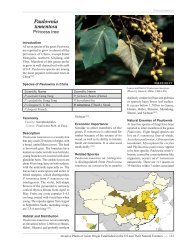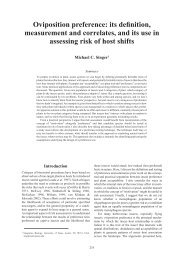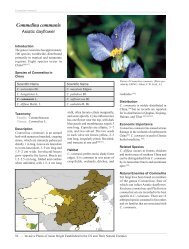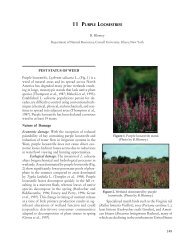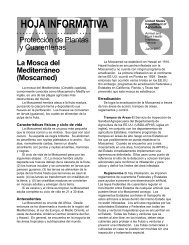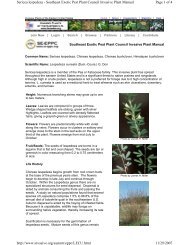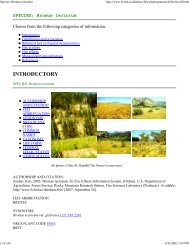A review of literature and field practices focused on ... - Invasive.org
A review of literature and field practices focused on ... - Invasive.org
A review of literature and field practices focused on ... - Invasive.org
You also want an ePaper? Increase the reach of your titles
YUMPU automatically turns print PDFs into web optimized ePapers that Google loves.
Mechanical C<strong>on</strong>trol - How To:<br />
H<str<strong>on</strong>g>and</str<strong>on</strong>g> Cutting<br />
Using a machete, loppers or pruning shears, cut the stems down to the ground surface as<br />
<str<strong>on</strong>g>of</str<strong>on</strong>g>ten as possible, but at least every 2-3 weeks from April (or as so<strong>on</strong> as the plant appears)<br />
through August. Sprouting slows after August, so you can reduce cutting frequency, but<br />
try <str<strong>on</strong>g>and</str<strong>on</strong>g> prevent the plants from ever exceeding six inches (15cm) in height. Pile the cut<br />
stems where they will quickly dry out.<br />
Mowing<br />
Using a weed-eater or mower, cut as low as possible <str<strong>on</strong>g>and</str<strong>on</strong>g> as <str<strong>on</strong>g>of</str<strong>on</strong>g>ten as possible, but at least<br />
every 2-3 weeks through August. Be sure you are not scattering stem or root fragments<br />
<strong>on</strong>to moist soil or into the water.<br />
Goats are reported to eat knotweed <str<strong>on</strong>g>and</str<strong>on</strong>g> in some circumstances c<strong>on</strong>trolled goat grazing<br />
may be an opti<strong>on</strong> similar to intensive mowing. Be aware they will eat desirable<br />
vegetati<strong>on</strong> as well.<br />
Digging/Pulling<br />
If the knotweed has established in s<str<strong>on</strong>g>of</str<strong>on</strong>g>t soil, or better yet s<str<strong>on</strong>g>and</str<strong>on</strong>g>, try pulling the plant <str<strong>on</strong>g>and</str<strong>on</strong>g><br />
major rhizomes up by the root crown to remove as much <str<strong>on</strong>g>of</str<strong>on</strong>g> the root system as you can.<br />
Although you will almost certainly not kill the plant in <strong>on</strong>e treatment, you will reduce the<br />
root mass. Each time you see new sprouts (start looking a week after you pull <str<strong>on</strong>g>and</str<strong>on</strong>g> search<br />
at least 20 feet away from the original plant), uproot them as well, trying to pull out as<br />
much <str<strong>on</strong>g>of</str<strong>on</strong>g> the root as you can each time. This is probably <strong>on</strong>ly feasible with small patches.<br />
Be sure to carefully dispose <str<strong>on</strong>g>of</str<strong>on</strong>g> any root material.<br />
Tilling<br />
Used al<strong>on</strong>e, tilling or otherwise physically disturbing the root system will not provide<br />
c<strong>on</strong>trol <str<strong>on</strong>g>and</str<strong>on</strong>g> will create many sprouts. This approach may however <str<strong>on</strong>g>of</str<strong>on</strong>g>fer some benefit in<br />
an integrated strategy, since it will increase the shoot to root ratio.<br />
Covering<br />
First cut stems down to ground surface (<str<strong>on</strong>g>and</str<strong>on</strong>g> possibly follow with tilling). Cover the area<br />
with thick black plastic or multiple layers <str<strong>on</strong>g>of</str<strong>on</strong>g> cardboard exp<str<strong>on</strong>g>and</str<strong>on</strong>g>ing bey<strong>on</strong>d the plant base<br />
<str<strong>on</strong>g>and</str<strong>on</strong>g> stems at least 2 meters (<str<strong>on</strong>g>and</str<strong>on</strong>g> preferably 7 meters) bey<strong>on</strong>d the outside stems. Weight<br />
down the covering material <str<strong>on</strong>g>and</str<strong>on</strong>g> watch the perimeters to be sure new stems are not<br />
popping up outside your cover material. Try this right at the beginning <str<strong>on</strong>g>of</str<strong>on</strong>g> the year or after<br />
you’ve cut the plant down a couple <str<strong>on</strong>g>of</str<strong>on</strong>g> times in the spring <str<strong>on</strong>g>and</str<strong>on</strong>g> reduced some <str<strong>on</strong>g>of</str<strong>on</strong>g> the rapid<br />
plant growth. It may be necessary to leave the plant covered through at least <strong>on</strong>e entire<br />
growing seas<strong>on</strong>.<br />
Comments <strong>on</strong> Manual C<strong>on</strong>trol <str<strong>on</strong>g>and</str<strong>on</strong>g> Combining Treatments<br />
No matter which c<strong>on</strong>trol method(s) is used, manual or mechanical c<strong>on</strong>trol is going to be a<br />
lot <str<strong>on</strong>g>of</str<strong>on</strong>g> work. But, combining digging/pulling with cutting or even herbicides use, helps<br />
break up the root system <str<strong>on</strong>g>and</str<strong>on</strong>g> encourages the plant to send up new shoots. The more<br />
shoots there are per linear foot <str<strong>on</strong>g>of</str<strong>on</strong>g> root, the more likely you will be to be able to physically<br />
pull them out, exhaust them by depriving them <str<strong>on</strong>g>of</str<strong>on</strong>g> energy (i.e. by cutting the shoot <str<strong>on</strong>g>of</str<strong>on</strong>g>f) or<br />
kill them with herbicides.<br />
12




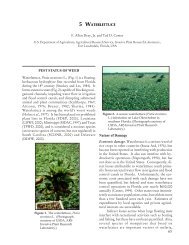

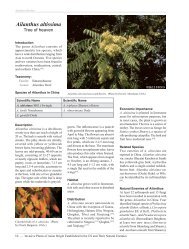
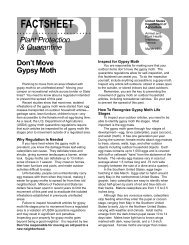
![A Guide to the Control and Management of Invasive Phragmites [PDF]](https://img.yumpu.com/27321025/1/190x190/a-guide-to-the-control-and-management-of-invasive-phragmites-pdf.jpg?quality=85)

